Seat Ibiza ST 2011 Owner's manual
Manufacturer: SEAT, Model Year: 2011, Model line: Ibiza ST, Model: Seat Ibiza ST 2011Pages: 280, PDF Size: 4.01 MB
Page 241 of 280
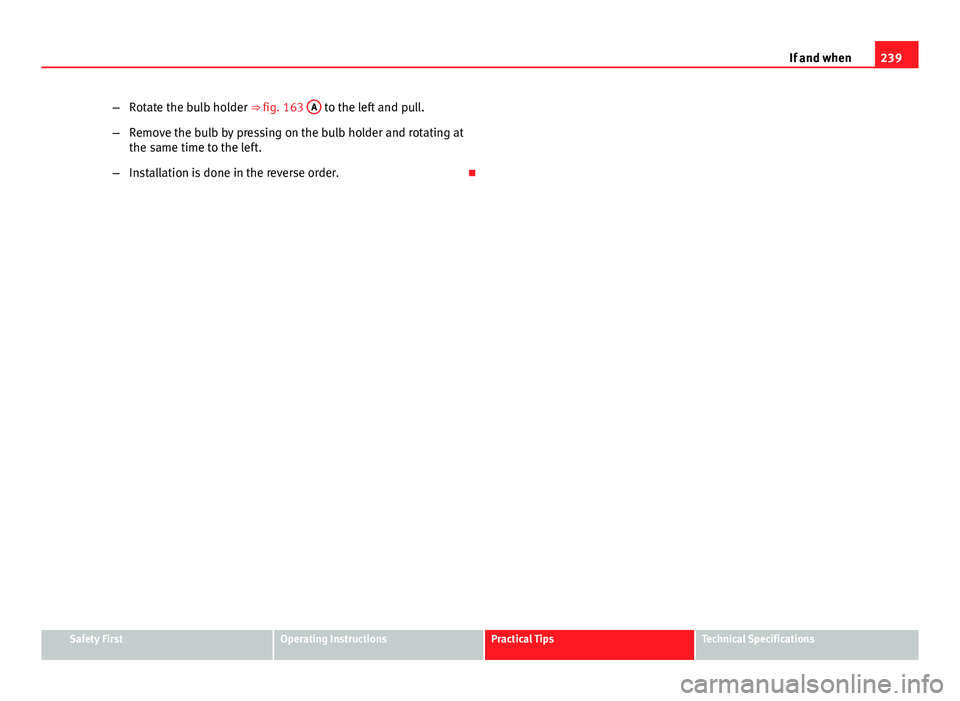
239
If and when
– Rotate the bulb holder ⇒ fig. 163 A
to the left and pull.
– Remove the bulb by pressing on the bulb holder and rotating at
the same time to the left.
– Installation is done in the reverse order.
Safety FirstOperating InstructionsPractical TipsTechnical Specifications
Page 242 of 280
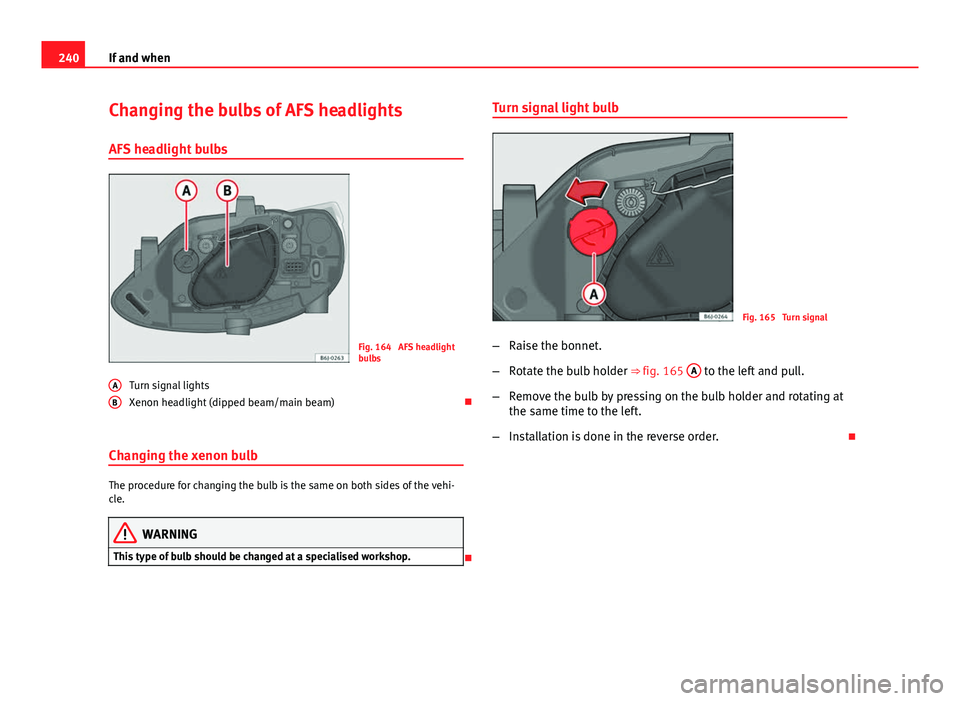
240If and when
Changing the bulbs of AFS headlights
AFS headlight bulbs
Fig. 164 AFS headlight
bulbs
Turn signal lights
Xenon headlight (dipped beam/main beam)
Changing the xenon bulb
The procedure for changing the bulb is the same on both sides of the vehi-
cle.
WARNING
This type of bulb should be changed at a specialised workshop.
A
B
Turn signal light bulb
Fig. 165 Turn signal
– Raise the bonnet.
– Rotate the bulb holder ⇒ fig. 165 A
to the left and pull.
– Remove the bulb by pressing on the bulb holder and rotating at
the same time to the left.
– Installation is done in the reverse order.
Page 243 of 280
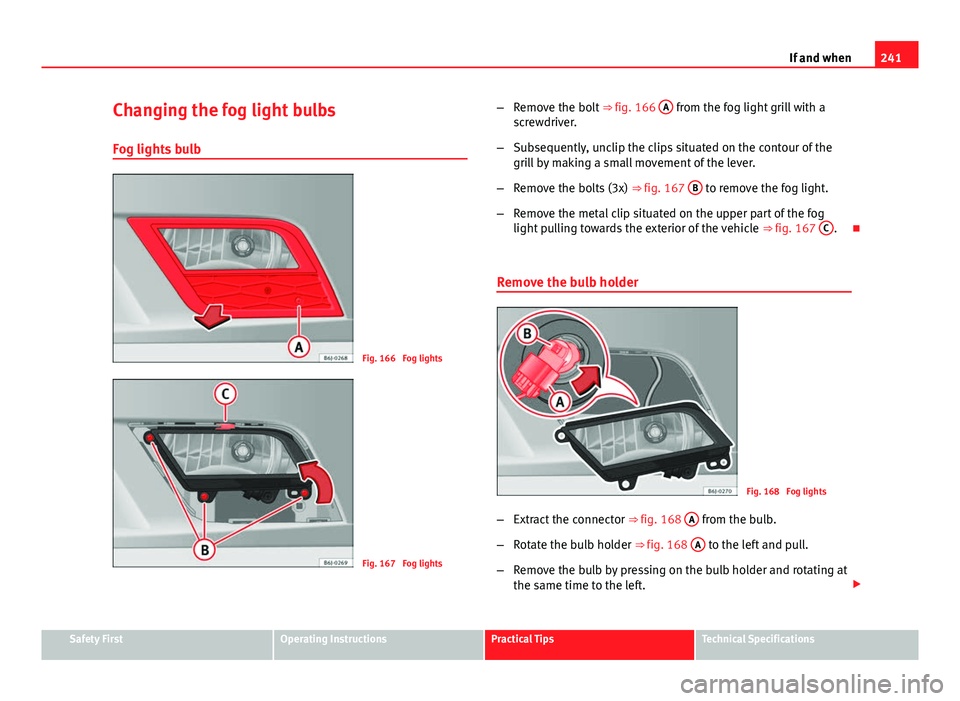
241
If and when
Changing the fog light bulbs
Fog lights bulb
Fig. 166 Fog lights
Fig. 167 Fog lights –
Remove the bolt ⇒ fig. 166 A
from the fog light grill with a
screwdriver.
– Subsequently, unclip the clips situated on the contour of the
grill by making a small movement of the lever.
– Remove the bolts (3x) ⇒ fig. 167 B
to remove the fog light.
– Remove the metal clip situated on the upper part of the fog
light pulling towards the exterior of the vehicle ⇒ fig. 167 C
.
Remove the bulb holder
Fig. 168 Fog lights
– Extract the connector ⇒ fig. 168 A
from the bulb.
– Rotate the bulb holder ⇒ fig. 168 A
to the left and pull.
– Remove the bulb by pressing on the bulb holder and rotating at
the same time to the left.
Safety FirstOperating InstructionsPractical TipsTechnical Specifications
Page 244 of 280
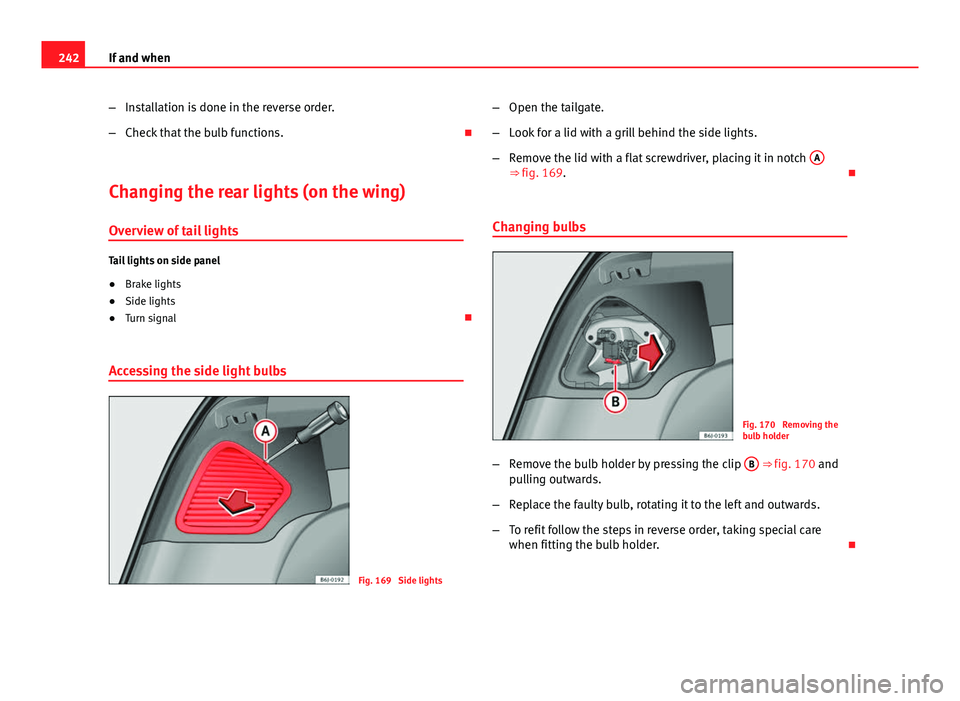
242If and when
–Installation is done in the reverse order.
– Check that the bulb functions.
Changing the rear lights (on the wing) Overview of tail lights
Tail lights on side panel
● Brake lights
● Side lights
● Turn signal
Accessing the side light bulbs
Fig. 169 Side lights –
Open the tailgate.
– Look for a lid with a grill behind the side lights.
– Remove the lid with a flat screwdriver, placing it in notch A
⇒ fig. 169.
Changing bulbs
Fig. 170 Removing the
bulb holder
– Remove the bulb holder by pressing the clip B
⇒ fig. 170 and
pulling outwards.
– Replace the faulty bulb, rotating it to the left and outwards.
– To refit follow the steps in reverse order, taking special care
when fitting the bulb holder.
Page 245 of 280
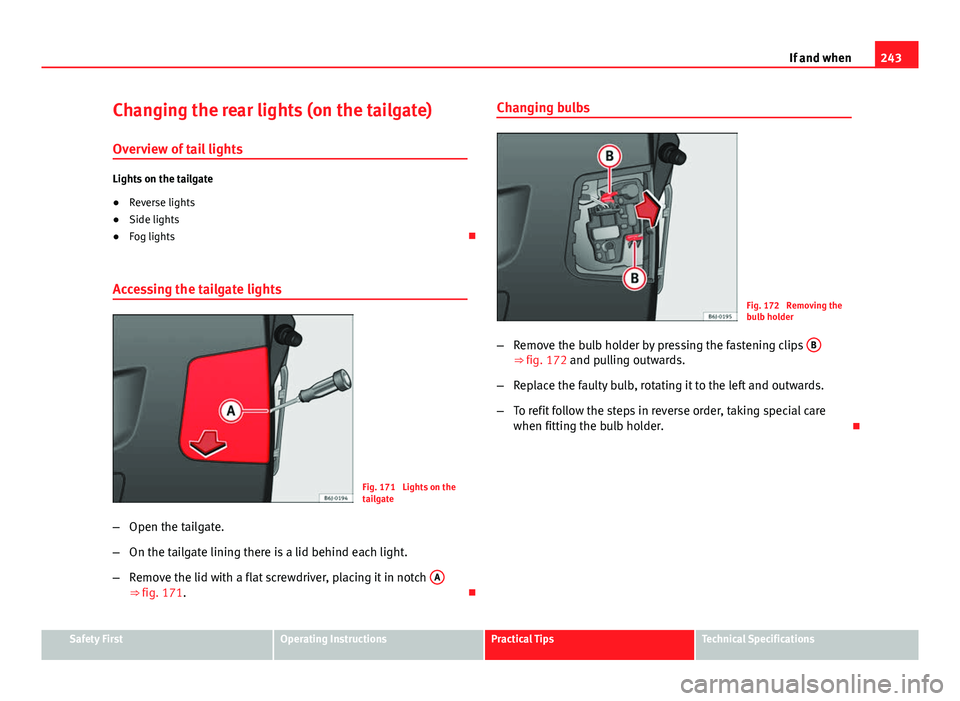
243
If and when
Changing the rear lights (on the tailgate) Overview of tail lights
Lights on the tailgate
● Reverse lights
● Side lights
● Fog lights
Accessing the tailgate lights
Fig. 171 Lights on the
tailgate
– Open the tailgate.
– On the tailgate lining there is a lid behind each light.
– Remove the lid with a flat screwdriver, placing it in notch A
⇒ fig. 171. Changing bulbs
Fig. 172 Removing the
bulb holder
– Remove the bulb holder by pressing the fastening clips B
⇒ fig. 172 and pulling outwards.
– Replace the faulty bulb, rotating it to the left and outwards.
– To refit follow the steps in reverse order, taking special care
when fitting the bulb holder.
Safety FirstOperating InstructionsPractical TipsTechnical Specifications
Page 246 of 280
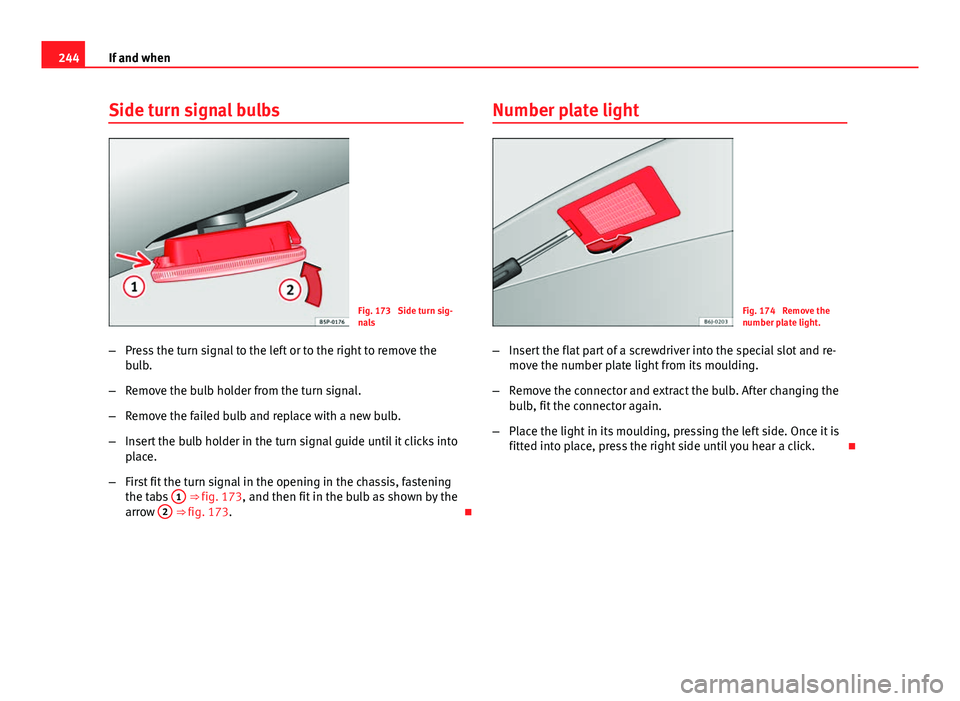
244If and when
Side turn signal bulbs
Fig. 173 Side turn sig-
nals
– Press the turn signal to the left or to the right to remove the
bulb.
– Remove the bulb holder from the turn signal.
– Remove the failed bulb and replace with a new bulb.
– Insert the bulb holder in the turn signal guide until it clicks into
place.
– First fit the turn signal in the opening in the chassis, fastening
the tabs 1
⇒ fig. 173, and then fit in the bulb as shown by the
arrow 2 ⇒ fig. 173. Number plate light
Fig. 174 Remove the
number plate light.
– Insert the flat part of a screwdriver into the special slot and re-
move the number plate light from its moulding.
– Remove the connector and extract the bulb. After changing the
bulb, fit the connector again.
– Place the light in its moulding, pressing the left side. Once it is
fitted into place, press the right side until you hear a click.
Page 247 of 280
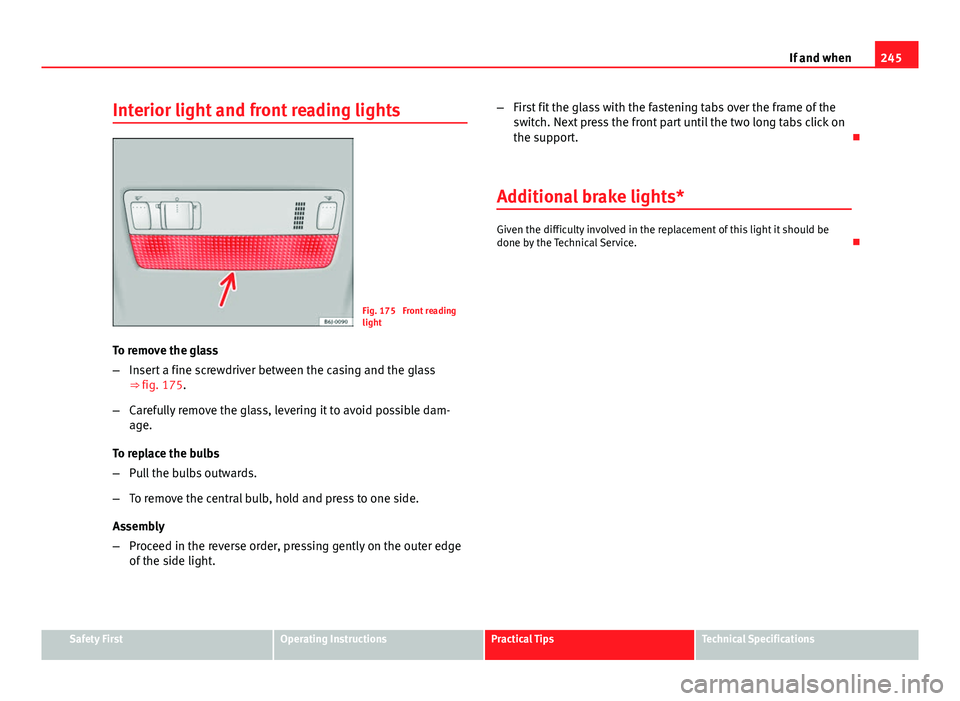
245
If and when
Interior light and front reading lights
Fig. 175 Front reading
light
To remove the glass
– Insert a fine screwdriver between the casing and the glass
⇒ fig. 175.
– Carefully remove the glass, levering it to avoid possible dam-
age.
To replace the bulbs
– Pull the bulbs outwards.
– To remove the central bulb, hold and press to one side.
Assembly
– Proceed in the reverse order, pressing gently on the outer edge
of the side light. –
First fit the glass with the fastening tabs over the frame of the
switch. Next press the front part until the two long tabs click on
the support.
Additional brake lights*
Given the difficulty involved in the replacement of this light it should be
done by the Technical Service.
Safety FirstOperating InstructionsPractical TipsTechnical Specifications
Page 248 of 280
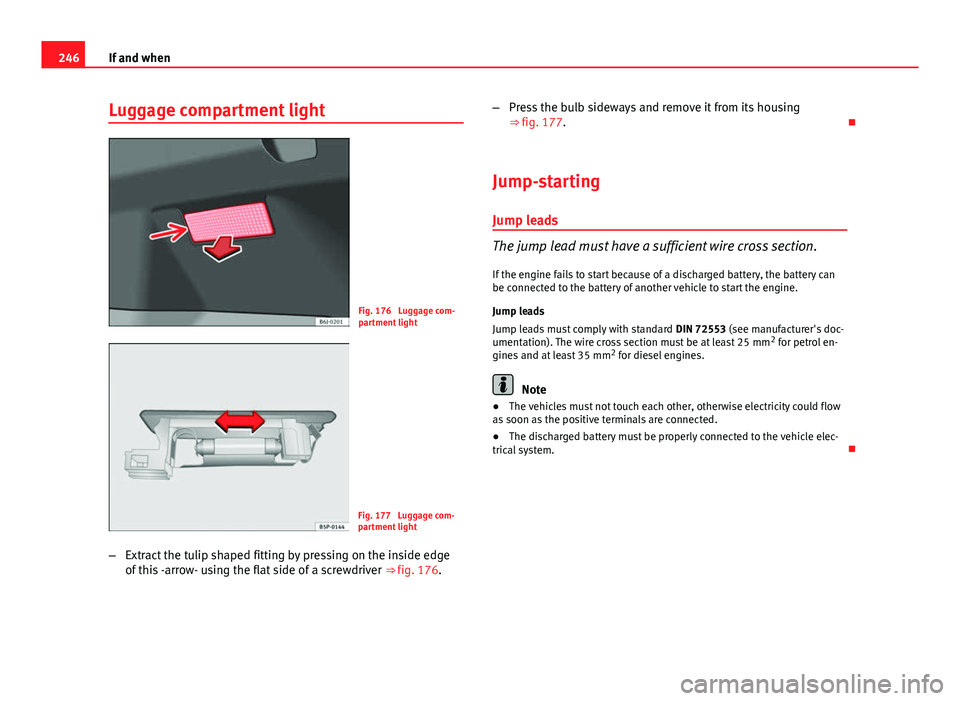
246If and when
Luggage compartment light
Fig. 176 Luggage com-
partment light
Fig. 177 Luggage com-
partment light
– Extract the tulip shaped fitting by pressing on the inside edge
of this -arrow- using the flat side of a screwdriver ⇒ fig. 176.–
Press the bulb sideways and remove it from its housing
⇒ fig. 177.
Jump-starting
Jump leads
The jump lead must have a sufficient wire cross section. If the engine fails to start because of a discharged battery, the battery can
be connected to the battery of another vehicle to start the engine.
Jump leads
Jump leads must comply with standard DIN 72553 (see manufacturer's doc-
umentation). The wire cross section must be at least 25 mm 2
for petrol en-
gines and at least 35 mm 2
for diesel engines.
Note
● The vehicles must not touch each other, otherwise electricity could flow
as soon as the positive terminals are connected.
● The discharged battery must be properly connected to the vehicle elec-
trical system.
Page 249 of 280
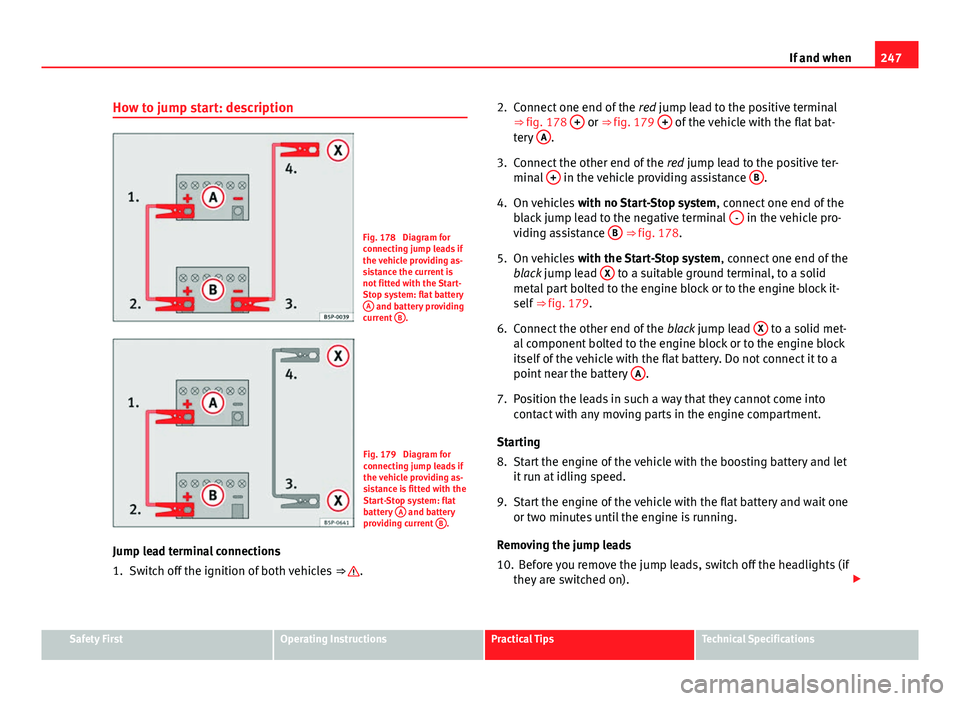
247
If and when
How to jump start: description
Fig. 178 Diagram for
connecting jump leads if
the vehicle providing as-
sistance the current is
not fitted with the Start-
Stop system: flat battery A
and battery providing
current B.
Fig. 179 Diagram for
connecting jump leads if
the vehicle providing as-
sistance is fitted with the
Start-Stop system: flat
battery A
and battery
providing current B.
Jump lead terminal connections
1. Switch off the ignition of both vehicles ⇒
.2. Connect one end of the
red jump lead to the positive terminal
⇒ fig. 178 +
or ⇒
fig. 179 + of the vehicle with the flat bat-
tery A.
3. Connect the other end of the red jump lead to the positive ter-
minal +
in the vehicle providing assistance B.
4. On vehicles with no Start-Stop system , connect one end of the
black jump lead to the negative terminal -
in the vehicle pro-
viding assistance B ⇒ fig. 178.
5. On vehicles with the Start-Stop system , connect one end of the
black jump lead X
to a suitable ground terminal, to a solid
metal part bolted to the engine block or to the engine block it-
self ⇒ fig. 179.
6. Connect the other end of the black jump lead X
to a solid met-
al component bolted to the engine block or to the engine block
itself of the vehicle with the flat battery. Do not connect it to a
point near the battery A
.
7. Position the leads in such a way that they cannot come into contact with any moving parts in the engine compartment.
Starting
8. Start the engine of the vehicle with the boosting battery and let it run at idling speed.
9. Start the engine of the vehicle with the flat battery and wait one or two minutes until the engine is running.
Removing the jump leads
10. Before you remove the jump leads, switch off the headlights (if they are switched on).
Safety FirstOperating InstructionsPractical TipsTechnical Specifications
Page 250 of 280
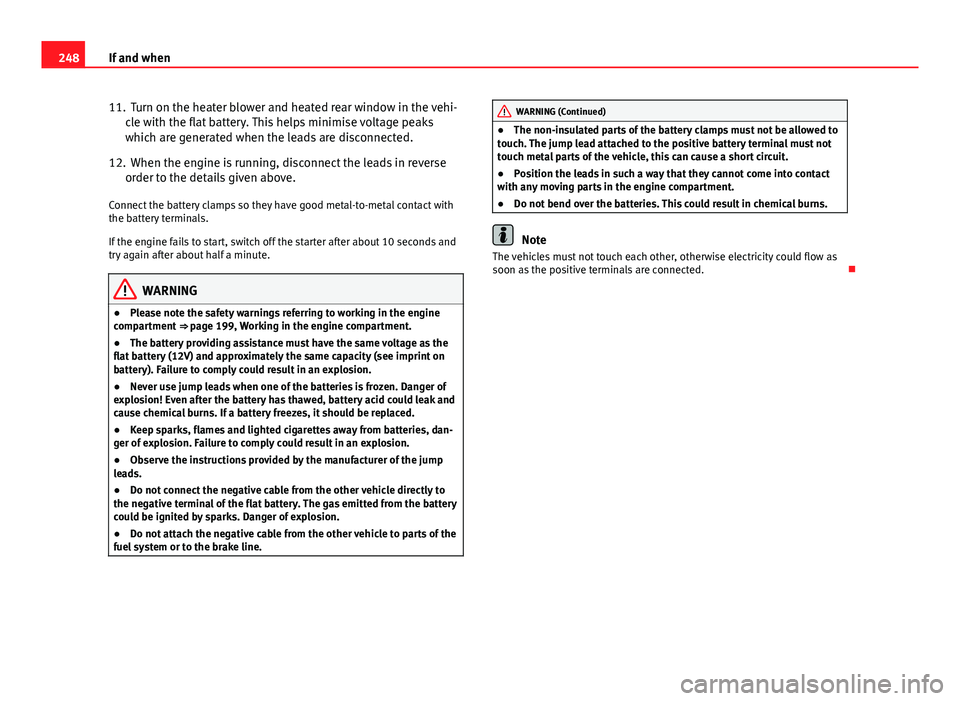
248If and when
11. Turn on the heater blower and heated rear window in the vehi-
cle with the flat battery. This helps minimise voltage peaks
which are generated when the leads are disconnected.
12. When the engine is running, disconnect the leads in reverse order to the details given above.
Connect the battery clamps so they have good metal-to-metal contact with
the battery terminals.
If the engine fails to start, switch off the starter after about 10 seconds and
try again after about half a minute.
WARNING
● Please note the safety warnings referring to working in the engine
compartment ⇒ page 199, Working in the engine compartment.
● The battery providing assistance must have the same voltage as the
flat battery (12V) and approximately the same capacity (see imprint on
battery). Failure to comply could result in an explosion.
● Never use jump leads when one of the batteries is frozen. Danger of
explosion! Even after the battery has thawed, battery acid could leak and
cause chemical burns. If a battery freezes, it should be replaced.
● Keep sparks, flames and lighted cigarettes away from batteries, dan-
ger of explosion. Failure to comply could result in an explosion.
● Observe the instructions provided by the manufacturer of the jump
leads.
● Do not connect the negative cable from the other vehicle directly to
the negative terminal of the flat battery. The gas emitted from the battery
could be ignited by sparks. Danger of explosion.
● Do not attach the negative cable from the other vehicle to parts of the
fuel system or to the brake line.
WARNING (Continued)
● The non-insulated parts of the battery clamps must not be allowed to
touch. The jump lead attached to the positive battery terminal must not
touch metal parts of the vehicle, this can cause a short circuit.
● Position the leads in such a way that they cannot come into contact
with any moving parts in the engine compartment.
● Do not bend over the batteries. This could result in chemical burns.
Note
The vehicles must not touch each other, otherwise electricity could flow as
soon as the positive terminals are connected.